 There were a couple in front of the scoreboard, playing bat & ball. Probably did better than some of the batsmen.
There were a couple in front of the scoreboard, playing bat & ball. Probably did better than some of the batsmen. And then there was time for a moment of reflection in a corporate box. I was outside, of course.
And then there was time for a moment of reflection in a corporate box. I was outside, of course.James
 There were a couple in front of the scoreboard, playing bat & ball. Probably did better than some of the batsmen.
There were a couple in front of the scoreboard, playing bat & ball. Probably did better than some of the batsmen. And then there was time for a moment of reflection in a corporate box. I was outside, of course.
And then there was time for a moment of reflection in a corporate box. I was outside, of course. We are torn between wanting to send and share them (some cards choose their own recipients) and wanting to treasure them 'as a set'.
We are torn between wanting to send and share them (some cards choose their own recipients) and wanting to treasure them 'as a set'. On opposite sides of a street near us the full lunacy plays out. A carefully tinselled 'BAH HUMBUG' on one side, while on the other characters enough to give any kid the heeby jeebies.
On opposite sides of a street near us the full lunacy plays out. A carefully tinselled 'BAH HUMBUG' on one side, while on the other characters enough to give any kid the heeby jeebies. Ah, well, you couldn't make it up.
Ah, well, you couldn't make it up.Dashing through the bush
In a rusty Holden Ute
Kicking up the dust
Esky in the boot
Kelpie by my side
Singing Christmas songs
It’s summer time and I am in
My singlet, shorts & thongs
CHORUS:
OH, JINGLE BELLS, JINGLE BELLS
JINGLE ALL THE WAY
CHRISTMAS IN AUSTRALIA
ON A SCORCHING SUMMER’S DAY
JINGLE BELLS, JINGLE BELLS
CHRISTMAS TIME IS BEAUT
OH WHAT FUN IT IS TO RIDE
IN A RUSTY HOLDEN UTEEngine’s getting hot
Dodge the kangaroos
Swaggy climbs aboard
He is welcome too
All the family is there
Sitting by the pool
Christmas day, the Aussie way
By the barbecue!CHORUS
From the BeautUtes website.Come the afternoon
Grandpa has a doze
The kids and uncle Bruce
Are swimming in their clothes
The time comes round to go
We take a family snap
Then pack the car and all shoot through
Before the washing upCHORUS
For those not fluent in Stryne, there is a translation here.
 These are Utes. Pic by James in Echuca.
These are Utes. Pic by James in Echuca.
James
 So the chunks were exactly the right size just like I like 'em.
So the chunks were exactly the right size just like I like 'em. Meanwhile in the Block Arcade, the Australian Girl's Choir were singing about figgy pudding. (Very nice, but figgy pudding was the last thing I think you'd want at 30 degrees...) The location of the view I had wasn't bad, either...
Meanwhile in the Block Arcade, the Australian Girl's Choir were singing about figgy pudding. (Very nice, but figgy pudding was the last thing I think you'd want at 30 degrees...) The location of the view I had wasn't bad, either... Well, that was a stunning finish. There have been a few times I've barracked for the team playing Australia, and I'm not ashamed to say this was one of them - and South Africa deserved to win.
Well, that was a stunning finish. There have been a few times I've barracked for the team playing Australia, and I'm not ashamed to say this was one of them - and South Africa deserved to win. In 2005, Lee triumphed over Kallis. At the WACA this game, Kallis laughed long. (BBC)
In 2005, Lee triumphed over Kallis. At the WACA this game, Kallis laughed long. (BBC)
Then in London:The Fens were sometimes deliberately flooded to allow skating, and Charles Pigg, a student at Peterhouse, challenged Bob Carpenter, a first-class cricketer with Cambridgeshire, to raise a side to play on a 20-acre site.
As expected, all players used skates. Cambridge Town batted first, closing the first two-hour day on 193 for 9. The following day, Wednesday, Carpenter and Dan Hayward added a further 132 in 70 minutes, the innings eventually totalling 326. Hayward's dismissal came about when he lost his footing, fell over and was bowled.
By the time the University batted the ice was rutted and worn, and while fielding continued to be a virtual lottery, batting became even harder. Despite this, they reached 61 for 1 by the end of the day. They extended this to 274 for 4 by the end of the third day and the captains agreed to settle on a draw.
"Fielding was delightful, and the chasing of the ball into space when it eluded you was most exhilarating," recalled Charles Boucher, whose full toss had dismissed Hayward, in a letter to the Times in 1929. "Only lob bowling was allowed and umpires were most severe on no-balls."
The most unusual contest took place on the ice in Windsor Park on January 9, 1879 under the light of the full moon.Thanks to that numbers repository, Cricinfo. And it's not just a historical anachronism; today you too can place Ice Cricket in Estonia, as offered here...
...several hundred spectators turned out to watch a Mr Gage's side score 17 for 8 to defeat a team raised by Mr Bowditch. "The game caused no end of amusement owing to the difficulties encountered by the players while bowling, batting and fielding," reported Wisden, perhaps slightly unfairly.



 Mitchell Johnson is congratulated by team-mates after claiming the wicket of Hashim Amla during the second day of the first Test between Australia and South Africa at the WACA Ground in Perth on December 18, 2008. (Tony McDonough)
Mitchell Johnson is congratulated by team-mates after claiming the wicket of Hashim Amla during the second day of the first Test between Australia and South Africa at the WACA Ground in Perth on December 18, 2008. (Tony McDonough)
 Eamonn McCabe, Beryl Bainbridge’s Room. From Writers’ Rooms. Archival digital print 29.5x42cm, paper size. Madison Contemporary Art, London.
Eamonn McCabe, Beryl Bainbridge’s Room. From Writers’ Rooms. Archival digital print 29.5x42cm, paper size. Madison Contemporary Art, London.  Eamonn McCabe. Craig Raine’s Room, from Writers’ Rooms. Archival digital print, 29.5x42cm, paper size.
Eamonn McCabe. Craig Raine’s Room, from Writers’ Rooms. Archival digital print, 29.5x42cm, paper size. We were lucky when we were in Florence that the weather was pretty good, and the tourists were at only a 0.7 of a RK 'Seethe'TM. Sometimes the light showed a view of something that's just so familiar you just don't see it properly any more. Above is an angle that just leapt out at me when we were down-sun of the Duomo. The backlit cross and ball on the dome were magical. (But of course, not quite as good as the far more classy Lucca Duomo. One must maintain one's loyalty to one's own Italian town. Florence remains just a slumming option for a Luccese boy.)
We were lucky when we were in Florence that the weather was pretty good, and the tourists were at only a 0.7 of a RK 'Seethe'TM. Sometimes the light showed a view of something that's just so familiar you just don't see it properly any more. Above is an angle that just leapt out at me when we were down-sun of the Duomo. The backlit cross and ball on the dome were magical. (But of course, not quite as good as the far more classy Lucca Duomo. One must maintain one's loyalty to one's own Italian town. Florence remains just a slumming option for a Luccese boy.) Then again, I know I'll never look at David's knees quite the same way in future.
Then again, I know I'll never look at David's knees quite the same way in future. After our visit to Trento in the the Italian highlands, we took the mountain road back to Treviso. Some of it was challenging driving, but the scenery was spectacular.
After our visit to Trento in the the Italian highlands, we took the mountain road back to Treviso. Some of it was challenging driving, but the scenery was spectacular. The courtyard in front of the new British Library on the Euston Road. Photo by James.
The courtyard in front of the new British Library on the Euston Road. Photo by James. The old British Library building in the centre of the British Museum. Who knows, the previous reader of the book could have been Karl Marx. Photo by James.
The old British Library building in the centre of the British Museum. Who knows, the previous reader of the book could have been Karl Marx. Photo by James.LIBRARY THIEF CONVICTED
Mr Farhad Hakimzadeh, a former British Library Reader, is due to appear at Wood Green Court today (Friday 21 November). Hakimzadeh has pleaded guilty to ten counts of theft from the Library, and asked for further charges to be taken into account. He has also admitted theft from the Bodleian Library in Oxford. Sentencing in this case is expected later today and you may have seen coverage of the case in this morning's press.
Hakimzadeh used considerable skill, deceit and determination to steal leaves, plates and maps from collection items. In many instances his thefts were initially difficult to detect. The items he mutilated are mainly 16th, 17th and 18th century items, with a lesser number of 19th and a few 20th century items. The predominant subject area is the West European engagement with Mesopotamia, Persia and the Mogul [Mughal] empire (roughly the area from modern Syria to Bangladesh), and western travel and colonisation / exploration.
Readers should be assured that theft from the British Library is an extremely rare occurrence. As Readers will appreciate, we are a library, not a museum. We are committed to making our collections available in the interests of scholarship and research, and to do this an element of trust is necessary. Hakimzadeh fundamentally betrayed this trust.
I know that Readers will share the anger we feel about this crime. The Library takes very seriously its duty to protect the collections for your use, and for the generations of Readers to come. We have zero tolerance of anyone who harms our collections and will pursue anyone who threatens them with utmost vigour.
Danger - Armed Librarians On Site.
The successful prosecution of Hakimzadeh follows a thorough and detailed investigation by Library staff and the Metropolitan Police. This led to the recovery of some of the items stolen by Hakimzadeh, and civil proceedings are now underway to recover further items and to seek financial compensation.
The Library has been heartened by the generous co-operation it has received during this investigation from a number of institutions and from other libraries in this country and abroad.
Should any Reader have a concern about the security of a collection item, please do speak to a member of Reading Room staff.
Dame Lynne Brindley
Chief Executive Officer
The British Library
 Here's some lurking at the end of our driveway from when we lived in Oxfordshire. There used to be dinosaurs here (the tracks remain). I reckon they're back.
Here's some lurking at the end of our driveway from when we lived in Oxfordshire. There used to be dinosaurs here (the tracks remain). I reckon they're back. We recently took in two Film Noir movies thanks to our local excellent independent video store. Both were surprising (which is, after all part of the point) one being excellent, the other thoroughly deserving the term pants*. The trick is that the awful one was a much-lauded early Hitchcock - The 39 Steps (1935 - IMDb page). Hitch is, rightly, regarded as one of the all time greats, but here he was having an off film - which has strangely garnered multiple great reviews.
We recently took in two Film Noir movies thanks to our local excellent independent video store. Both were surprising (which is, after all part of the point) one being excellent, the other thoroughly deserving the term pants*. The trick is that the awful one was a much-lauded early Hitchcock - The 39 Steps (1935 - IMDb page). Hitch is, rightly, regarded as one of the all time greats, but here he was having an off film - which has strangely garnered multiple great reviews. I checked the box to ensure we'd got the right film, and we had. The reviewers seem to have seen another film to the one we saw. The reviewers example apparently had continuity, acting and a plot that would convince someone over six. In ours, star Robert Donat playing Hannay as a bizarre Canadian (rather than the book's South African) is 'suave' to the point of being smarmy.
I checked the box to ensure we'd got the right film, and we had. The reviewers seem to have seen another film to the one we saw. The reviewers example apparently had continuity, acting and a plot that would convince someone over six. In ours, star Robert Donat playing Hannay as a bizarre Canadian (rather than the book's South African) is 'suave' to the point of being smarmy. Perhaps it's because the original The 39 Steps book by John Buchan is a firm favourite we were a bit more critical, but considering Hitch and the scriptwriters had thrown the entire plot into a blender that's hardly a germane criticism. The bizarre mix of location work and studio Scottish moors with papier-mâché rocks was amusing, but the nadir was speeding up the film of police chasing our hero across the moor... No, that belongs only in the Keystone Cops. The ending was risible.
Perhaps it's because the original The 39 Steps book by John Buchan is a firm favourite we were a bit more critical, but considering Hitch and the scriptwriters had thrown the entire plot into a blender that's hardly a germane criticism. The bizarre mix of location work and studio Scottish moors with papier-mâché rocks was amusing, but the nadir was speeding up the film of police chasing our hero across the moor... No, that belongs only in the Keystone Cops. The ending was risible. These stills have been lifted from this site, that offers a stop motion version of Hitch's film. If you must waste time on it, this is a good short cut..
These stills have been lifted from this site, that offers a stop motion version of Hitch's film. If you must waste time on it, this is a good short cut.. Nevertheless, it set up several remarkable scenarios, was well paced and had several genuine surprising shocks and twists, and a great ending.
Nevertheless, it set up several remarkable scenarios, was well paced and had several genuine surprising shocks and twists, and a great ending.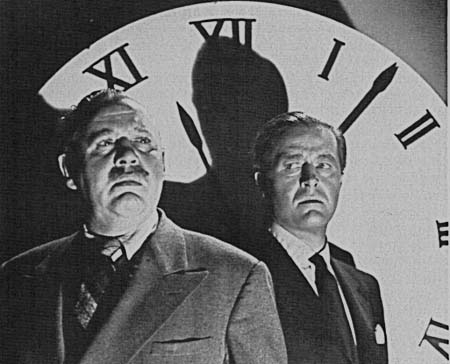
Additionally, the Janoth Publications building where most of the action takes place is almost a cast member in itself, an art deco wonder, especially the room housing the clock mechanism and the lobby and vestibules, all loosely inspired by such structures as the Empire State Building and the real-life Daily News headquarters on East 42nd Street.The film is based on a book by author and poet Kenneth Fearing. It was, apparently, his big breakthrough, and made him a mint, but he signed away the film rights and drank himself to death. One quote hit a note:
People who worked with him remember that in the afternoons he would have to put his head on his typewriter and sleep.Hmmm. A modern keyboard just won't do. Still this plot's a great legacy.
 As you'd want, from this review featuring Noir, there was a twist or two. Confess you expected the Hitchcock effort to be the success, and The Big Clock to be the fall guy!
As you'd want, from this review featuring Noir, there was a twist or two. Confess you expected the Hitchcock effort to be the success, and The Big Clock to be the fall guy! CUT & PRINT!
CUT & PRINT! In an earlier blog I was quite rude about roses. One of my reasons for dislike is they aren't Australian natives, and as Australia has a huge array of amazingly bright and varied native flowers, the obsession with roses by many is a pity, as it displaces interesting and rarer natives from Australian gardens. More importantly, and funnily enough, the natives are more suited to Australian conditions, generally being less demanding than the aliens.
In an earlier blog I was quite rude about roses. One of my reasons for dislike is they aren't Australian natives, and as Australia has a huge array of amazingly bright and varied native flowers, the obsession with roses by many is a pity, as it displaces interesting and rarer natives from Australian gardens. More importantly, and funnily enough, the natives are more suited to Australian conditions, generally being less demanding than the aliens. One of the greats is the Bottlebrush, formally the Callistemon. Here we see a red Bottlebrush local to us, which is just flowering. I think it's the cultivar known as Harkness.
One of the greats is the Bottlebrush, formally the Callistemon. Here we see a red Bottlebrush local to us, which is just flowering. I think it's the cultivar known as Harkness.
 It's a splash of colour which always gives a lift.
It's a splash of colour which always gives a lift.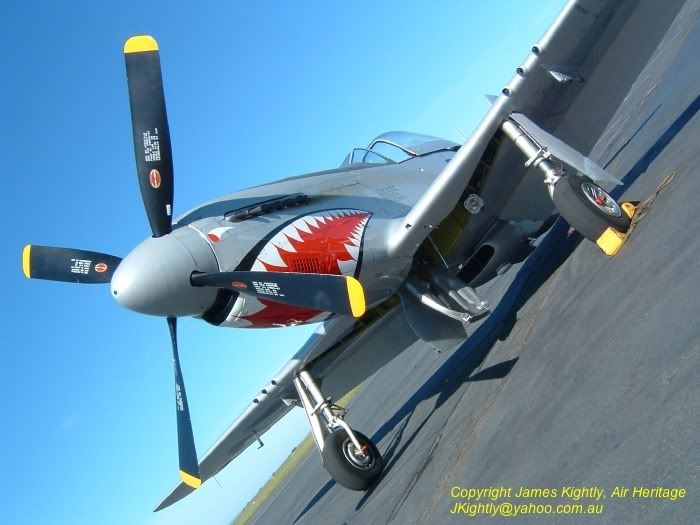 Some kids like diggers. Some kids like dinosaurs. There's something about a combine harvester. But then, some kids like aeroplanes and don't grow out of it. This beastie's always popular with the kids.
Some kids like diggers. Some kids like dinosaurs. There's something about a combine harvester. But then, some kids like aeroplanes and don't grow out of it. This beastie's always popular with the kids.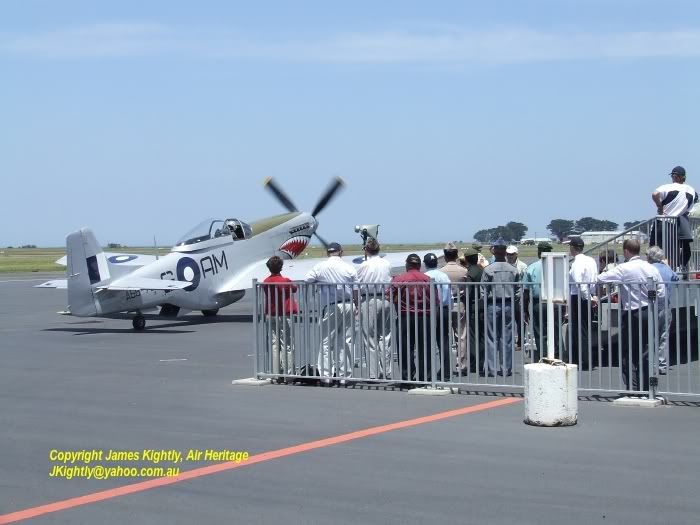 There's a lot of history to go behind it, but we'll suffice with the fact it's the Royal Australian Air Force Museum's CAC Mustang. (The RAAF Museum is where I act as a volunteer guide about once a week.) This Mustang is flown about once a month, to an always delighted crowd.
There's a lot of history to go behind it, but we'll suffice with the fact it's the Royal Australian Air Force Museum's CAC Mustang. (The RAAF Museum is where I act as a volunteer guide about once a week.) This Mustang is flown about once a month, to an always delighted crowd.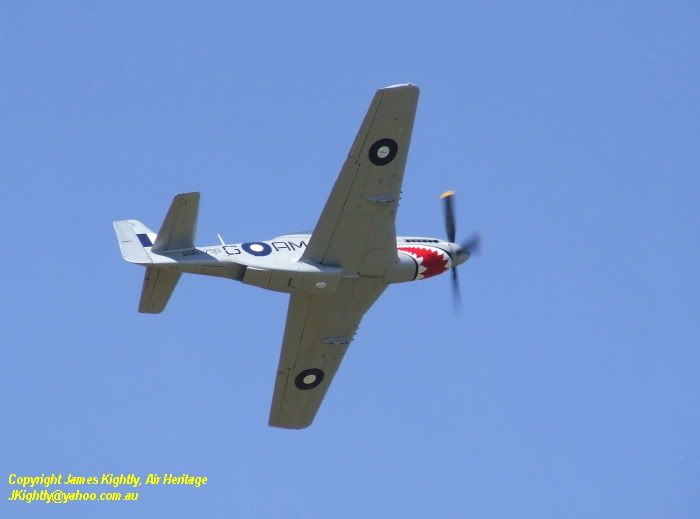 It's still owned by the RAAF, and is the only active Mustang in Air Force (or government) ownership anywhere in the world - out of several hundred flyers around the globe.
It's still owned by the RAAF, and is the only active Mustang in Air Force (or government) ownership anywhere in the world - out of several hundred flyers around the globe.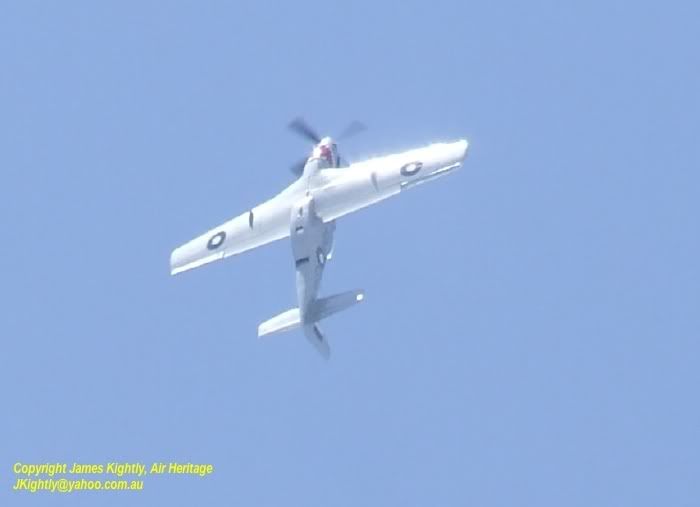 But the main thing is it's got a cool shark's mouth. Beats a digger any day.
But the main thing is it's got a cool shark's mouth. Beats a digger any day. James
James Poppies in Oxfordshire. B&J.
Poppies in Oxfordshire. B&J. McCrae's pistol. J.
McCrae's pistol. J.In Flanders fields the poppies blow
Between the crosses, row on row,
That mark our place; and in the sky
The larks, still bravely singing, fly
Scarce heard amid the guns below.
We are the Dead. Short days ago
We lived, felt dawn, saw sunset glow,
Loved and were loved, and now we lie
In Flanders fields.
Take up our quarrel with the foe:
To you from failing hands we throw
The torch; be yours to hold it high.
If ye break faith with us who die
We shall not sleep, though poppies grow
In Flanders fields.
 A minutes silence, and flag at half-mast at Echuca, Vic, 2006. J.
A minutes silence, and flag at half-mast at Echuca, Vic, 2006. J. The interior of the Royal Exhibition Building, Melbourne. Used for just about everything, since 1880, in 1918 this was an emergency flu hospital. J.
The interior of the Royal Exhibition Building, Melbourne. Used for just about everything, since 1880, in 1918 this was an emergency flu hospital. J.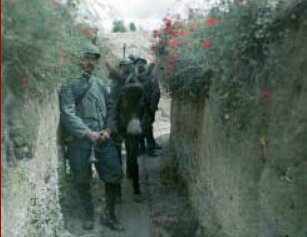 French trench with a donkey and poppies. This is the only colour photograph (one of two processes used at the time) known to show poppies on the battlefield, and was taken in 1915 by an official French war photographer.
French trench with a donkey and poppies. This is the only colour photograph (one of two processes used at the time) known to show poppies on the battlefield, and was taken in 1915 by an official French war photographer.  James
James
 Kind of sounds attractive, doesn't it? As you can tell from the prices, address and typography, we are in the 1930s. The autogiro (patented name of the Cierva company, otherwise they're autogyros) was an attempt to build a 'safe' aircraft, pioneered in the inter war period by Spaniard Juan de la Cierva. Many of the principles his team discovered went on to be used in the development of the helicopter, while tragically he was killed in the 1936 crash of an airliner - exactly the sort of accident he was trying to overcome with the autogiro.
Kind of sounds attractive, doesn't it? As you can tell from the prices, address and typography, we are in the 1930s. The autogiro (patented name of the Cierva company, otherwise they're autogyros) was an attempt to build a 'safe' aircraft, pioneered in the inter war period by Spaniard Juan de la Cierva. Many of the principles his team discovered went on to be used in the development of the helicopter, while tragically he was killed in the 1936 crash of an airliner - exactly the sort of accident he was trying to overcome with the autogiro.